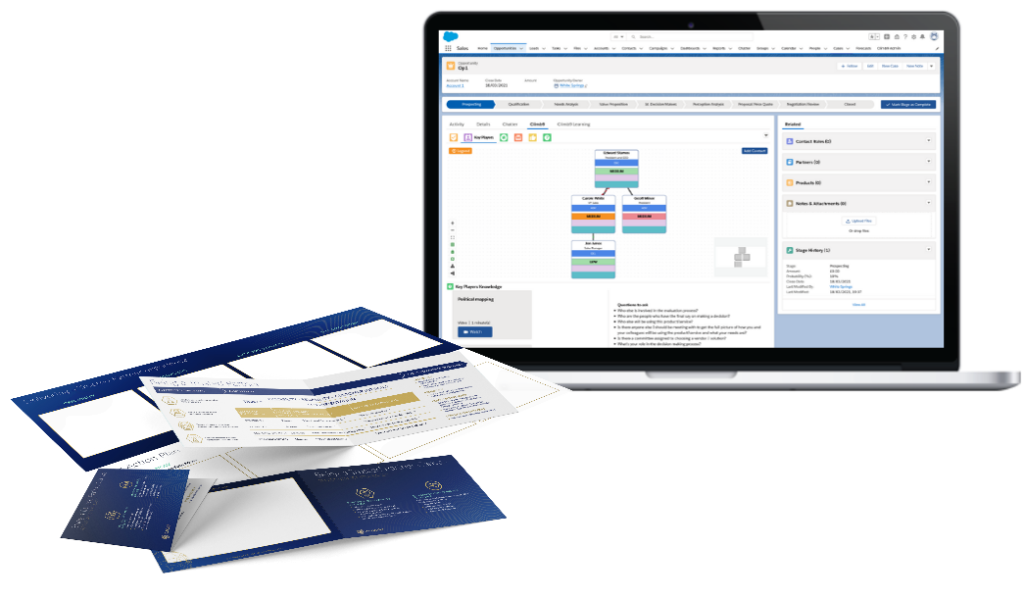Design Thinking for Sales

3DDTfS
3D Design Thinking for Sales
Embrace a new style of selling.
Design Thinking identifies and solves problems creatively and iteratively, with a focus on the human need being addressed. Traditionally, the Design Thinking process has been associated with innovation and product development, but it turns out that it is also highly applicable in a sales context. A Design Thinking approach to selling – in essence, empathising with the customer’s need and then jointly designing sustainable solutions – can create superior outcomes to more traditional sales approaches, as it places both the buyer and the seller firmly ‘on the same side of the table’.
The 3D Design Thinking for Sales programme will help your sales teams adopt a new approach to selling, where customer-centricity, trust and collaboration increase the value created for your clients. It is based on more than 20 years of quantitative, qualitative and field-based sales research. It forms part of Imparta’s 3D Curriculum, which helps sales professionals to create, differentiate, protect, capture, deliver and expand value around the whole customer Buying Cycle.
Completing this course will help participants know when and how to use the powerful tools in Design Thinking for Sales. They will explore the iDEATE sales process, a framework that guides them to identify problems worth solving, diagnose them, explore solutions, agree on the best solution(s) to pursue, test and prototype the solution, and finally execute and evaluate the result, learning from what works well and what doesn’t.
This highly interactive programme develops lasting consultative selling skills through a comprehensive set of application and real-life exercises, tools and reinforcement techniques within Imparta’s continuous improvement ecosystem.

Course Overview
Key training topics include:
- High-level introduction to Design Thinking as a different type of selling; intelligence around how and when to use it.
- The iDEATE process for Design Thinking for Sales.
- Empathising with stakeholders to uncover unmet objectives.
- Using Behavioural Economics to stimulate the need to act.
- Problem definition techniques: problem statements, root cause analysis, and the creation of user stories.
- Exploring solutions through creativity; assessing the value of those solutions, identifying and alleviating risk, and presenting recommendations.
- Overview of prototyping approaches and how to select the most appropriate one to provide a low-cost, low-risk and rapid way to iterate towards a great solution design.
- Managing effective implementation and adoption processes: Time to First Value and techniques to minimise it.

Impact
The 3D Design Thinking for Sales programme has been shown to improve:
- Account penetration and entanglement.
- Conversion, win and renewal rates.
- Revenue and profit from new and existing accounts (share of wallet, up-selling, cross-selling).
- Contractual periods and average deal size.
- Customer, user experience.
Secondary benefits include:
- Long-term sustainability of the solutions sold.
- Creation of references and case studies that can be leveraged to generate further leads.
- Differentiation as a Trusted Partner.
Imparta’s iDEATE Process
The diagram below summarises Imparta’s iDEATE process. Most deals iterate between different stages, often moving back to a previous stage as more information is uncovered. You can see how our 3D Advantage® framework of Insight, Influence and Trust informs each stage of the process.
| I | D | E | A | T | E | |
|---|---|---|---|---|---|---|
| Identify | Define | Explore | Agree | Test | Execute | |
| Identify and validate problems worth solving | Define the problem and diagnose root cause(s) | Explore possible solutions | Select and present the best solution | Use rapid prototyping to test the solution | Implement and follow up to keep learning | |
| INSIGHT | • Identify unmet business objectives using the Value Chain • Identify unmet human objectives through Empathy Mapping | • Define what, why, where, who and when • Identify root causes • Create User Stories to capture requirements | • Set boundaries • Don’t over-design • “Yes, and…” • Break the rules • Reversal • SCAMPER | • Consider Strategic, Tactical, Political and Individual benefits • Assess benefits vs. cost/ effort for each solution • Identify & alleviate risk | • Use rapid-cycle prototyping • Select the right level of prototyping, and a suitable technology | • Evaluate results • Follow up: Could you use iDEATE better? • Create effective user communications • Skill, Will and Way |
| INFLUENCE | • Ask, don’t just tell • Explore Pain & Gain to build momentum & validate | • Use problem definition to get closer to the customer and make a win more likely | •Co-create! •Collaborate with technical specialists | • Present multiple options (avoid single option aversion) | • Engage the customer in the prototyping process • Gather data | • Minimise TTfV • ‘Wow!’ moments • Engage customer in the evaluation loop |
| TRUST | • Show empathy • Listen actively | • Business intimacy • Be customer-centric | • Bring credibility • Low self-orientation | • Realistic estimates • Focus on the need | • Gather customer viewpoint (intimacy) | • Be reliable • Follow up |

Who is it For?
This programme is designed for salespeople and adjacent roles involved in consultative, value-based selling and/or solution selling for both products or services.
Design Thinking for Sales is particularly relevant where:
- Buyers are not fully aware of their problems, or of possible solutions. (Design Thinking offers a very effective discovery process).
- Salespeople don’t have access to buyers. (Design Thinking offers a very quick way to build trust).
- Salespeople have very good access to buyers. (Design Thinking is also a great way to leverage strong existing relationships).
- The need is complex, has a strong human element, The solution is complex, needs extensive configuration or requires creativity to design.

Formats and Duration
The programme is part of Imparta’s modular curriculum.
It is available as:
- eLearning (full modules, plus individual assets that can be embedded into playbooks).
- A 2-day instructor-led face-to-face workshop.
- 4 four-hour virtual instructor-led sessions.
- Flipped learning where the classroom is used to focus on application.
- Modules that can be combined with other courses.
The programme also includes competency definitions, application tools, measurement, and reinforcement tools including nudge questions and manager coaching guides to make the new skills stick.

Application Tools
Application tools (Canvases) are available in print, editable PDF and Excel versions. They are also available as native Salesforce tools and standalone tools within our platform.
The Canvases help attendees to embed their new skills, and to apply them to identifying, defining, and solving new customer needs.

Explore the modules
Design Thinking for Sales
Impact: All
Understand the importance of taking a Design Thinking approach in Sales. Use the iDEATE process to identify problems, diagnose them, explore solutions, agree the best solution(s) to pursue, test and prototype, and finally execute and evaluate the outcomes, learning from what works well and what doesn’t.

Identify Problems
Impact: Number of Leads; Deal Size
Explore the customer’s unmet objectives and empathise with key stakeholders to uncover their human needs. Use pain and gain questions to shed light on the impact of not acting and validate the importance of the problem. Build momentum through loss aversion and contrast bias.

Define the Problem
Impact: Conversion rate; Deal Size
Define (and redefine) problems clearly and accurately. Build skills in three techniques to support this: problem statement definition, root cause analysis, and the creation of user stories.

Explore Solutions
Impact: Conversion rate; Deal Size
Use insight and creativity to explore possible solutions to the root problem, uncovering options with different levels of cost and impact. Leverage formal creativity tools such as Reversal, SCAMPER and Break the Rules to help generate a wide set of possible solutions.

Agree the Solution
Impact: Conversion Rate, Sales Cycle Time, Average Deal Size
Understand how customers assess the costs and benefits of a solution and use the cost/ benefit grid to prioritise options. Improve solutions by identifying and alleviating risks. Present the customer with more than one choice, to avoid Single Option Aversion.

Test and Prototype
Impact: Time to First Value, account growth
Select the most appropriate prototyping approach and technology to provide a low-cost, low-risk and rapid way to iterate towards a great solution design. Engage with the customer in the prototyping process, using data to enhance the solution, prove that it works, and support the investment.

Execute and Evaluate
Impact: Time to Value, Account growth, Share of Wallet, Renewal Rate
Understand the importance of Time to First Value (TTFV) and design implementation and adoption processes to minimise TTFV. Proactively evaluate the solution to keep learning from what works and what doesn’t.

Working with us also means
An annual fee per user gives you access to the whole curriculum, as needed, for around the cost of a single course each year. Even trainer days can be bought on subscription, allowing you to budget ahead and respond quickly as your markets change.
We work with companies across the globe, drawing on over 100 facilitators around the world and our in-house translation team.
Imparta’s i-Coach® platform is an award-winning LMS/LXP that powers each of the 5C use-cases for front-line capability building. Or you can deploy the entire 3D Advantage® Curriculum using your own platform.






